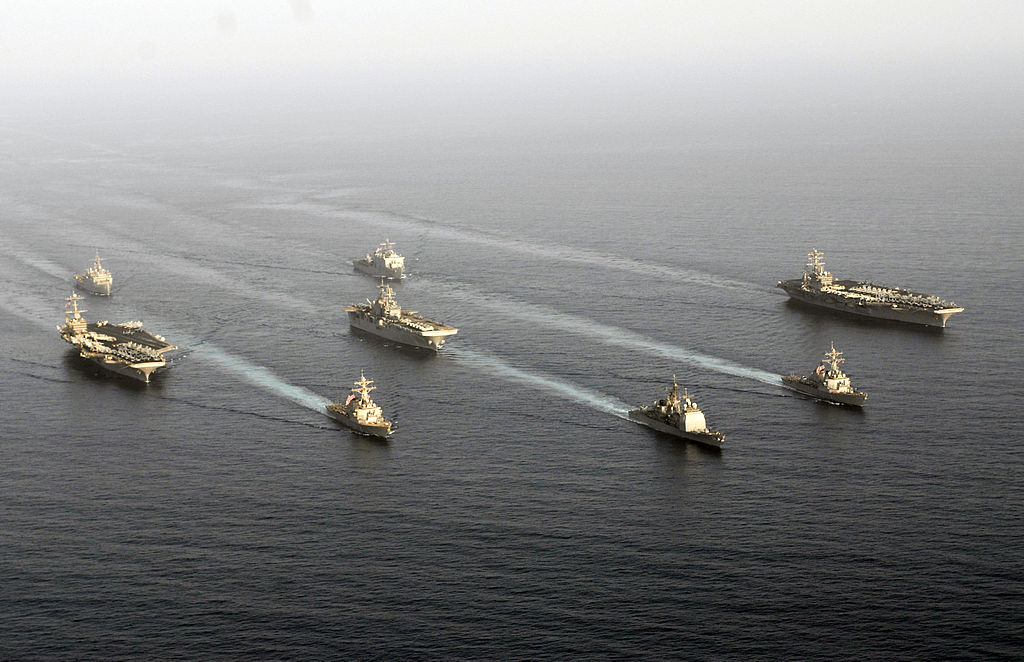Does the U.S. Currently Have a Right of Self-Defense Against Iran?
As most Lawfare readers know, the United States accused Iran of attacking two oil tankers on June 13 in the Gulf of Oman and crippling the ships with explosions that were presumably caused by naval mines. One tanker was flagged to Japan and the other to Norway.

Published by The Lawfare Institute
in Cooperation With

As most Lawfare readers know, the United States accused Iran of attacking two oil tankers on June 13 in the Gulf of Oman and crippling the ships with explosions that were presumably caused by naval mines. One tanker was flagged to Japan and the other to Norway. The United States released a video that it claims shows men on an Iranian Revolutionary Guard Corps (IRGC) boat pulling a limpet mine off one of the tankers, but several other states—including Germany and Norway—have said that the video does not conclusively show what happened. In addition, the United States accused Iran of trying to shoot down a U.S. drone (an MQ-9 Reaper) that was surveilling one of the vessels in the aftermath of the explosion. The shot—from a “modified Iranian SA-7 surface-to-air missile”—missed the Reaper by about one kilometer.
The Trump administration has not yet announced what steps it plans to take in response. President Trump described the attacks as “very minor” and, when asked if he was considering military action, told Time, “I wouldn’t say that.” However, Secretary of State Mike Pompeo stated on CBS’s Face the Nation that the United States “is considering a full range of options” in response. When the interviewer asked if that included a military response, Pompeo said, “Of course.” At least one member of Congress, Rep. Adam Kinzinger, told Fox News he would have ordered military strikes against Iran in response to the attacks on the oil tankers, including taking out “some of their military infrastructure, their fast boat infrastructure, their ability to mine this area and also maybe surface-to-air missile sites.”
Assume that the United States could attribute these kinetic operations to Iran with a very high degree of certainty. Pompeo’s and Kinzinger’s comments make it worth asking: Would the United States then have the right under international law to use force against Iran in self-defense? The answer is unclear, even under current U.S. interpretations of jus ad bellum rules. The views of the United States and other interested states might, however, deviate along two axes: the debate about whether all uses of force constitute armed attacks and the debate about what requirements must be met before a state acts in collective self-defense of another state.
First, consider the oil tankers, neither of which had U.S. citizens serving on their crews. Each ship was damaged by blasts and subsequent fires on the ships, presumably caused by mines. No crew members were killed. We should start from the perspective of the states most directly affected by the explosions: the vessels’ flag states. From Norway’s perspective, were these armed attacks by Iran that triggered Norway’s right to use force in self-defense? Probably not. Although I have not been able to find specific statements by Norway on the subject, I assume that Norway follows the view of the International Court of Justice (ICJ), first expressed in the Nicaragua case, that “armed attacks” include only “the most grave forms of the use of force.” The use of a mine that damaged but did not sink a commercial vessel and caused no loss of life does not fit into that category, however noxious the act is along other dimensions. Norway might also conclude that a forcible response was not “necessary”—another customary international law requirement for the use of force—because it believes that diplomacy or economic pressure might be effective in prompting the Iranian government to bring the IRGC to heel.
The United States might reach a different conclusion about whether the mine explosions constituted an armed attack. In 1987, during the Iran-Iraq “Tanker War,” in which both states attacked military and commercial vessels of various nationalities, the United States reflagged 11 Kuwaiti vessels and provided them with naval escorts. Nevertheless, one reflagged vessel was hit by a missile in Kuwaiti waters, injuring six crew members and damaging the ship. The United States concluded that Iran was responsible for the missile attack and responded by damaging two Iranian oil platforms. Several months later, the USS Samuel B. Roberts hit a mine in international waters while returning from an escort mission and was seriously damaged; again, the United States concluded that Iran had laid the mine and used force against two other Iranian oil platforms.
In the wake of the U.S. uses of force, Iran brought a case against the United States in the ICJ. The ICJ concluded that, among other things, the missile and mining operations, even if attributable to Iran, did not rise to the level of an “armed attack.” Then-Legal Adviser Will Taft wrote an essay objecting to several of the ICJ’s conclusions. He rejected the idea that an attack required a particular level of gravity to constitute an “armed attack” and stated that
there is no support in international law or practice for the suggestion that missile and mine attacks carried out by a State’s regular armed forces on civilian and military targets of another State do not trigger a right of self-defense. ... [I]f the United States is attacked with deadly force by the military personnel of another state, it reserves its inherent right preserved by the U.N. Charter to defend itself and its citizens.
Mines can produce deadly force, even if they happily didn’t do so in this case, and the IRGC constitutes part of Iran’s armed forces. Thus, the United States might conclude generally that the use of mines by the IRGC to damage commercial vessels constitutes an act that triggers a right of self-defense, at least for the flag state.
Remember, however, that the direct state victims in this case are Japan and Norway, not the United States. If Japan or Norway concluded that the explosions constituted an armed attack and were confident that Iran was the perpetrator, either state could ask the United States for assistance in responding, invoking the concept of collective self-defense. Here too, however, there are different views about what is required to institute an action in collective self-defense. The ICJ in the Nicaragua case asserted that the victim state must declare itself to be a victim of an armed attack and must request military aid in response. Some scholars and states have questioned whether that position has support in customary international law, though Japan has repeatedly supported the ICJ view. The United States takes the position that collective defense of a state can proceed only with the victim state’s consent but that the victim state need not necessarily make an explicit request. (See the Defense Department’s Law of War Manual, Section 1.11.5.5.)
This consent requirement would apply, even though the United States has a collective self-defense treaty with Japan that anticipates U.S. involvement in Japanese actions taken in self-defense. The 2015 Guidelines for Japan-U.S. Defense Cooperation specifically envision “[b]ilateral actions in response to an armed attack against Japan” as a “core aspect of Japan-U.S. security and defense cooperation.” Therefore, if Japan were to inform the United States that it affirmatively did not consent to the U.S. using force on its behalf in collective self-defense, the United States would not be able to rely on a collective self-defense justification for acting against Iran. A similar analysis presumably also holds true for Norway, a member of NATO. NATO operates by consensus; if Norway rejects the idea that it has suffered an armed attack, NATO’s member states would be unable to invoke Article V’s collective self-defense provision.
What about Iran’s effort to shoot down a U.S. Reaper? (Although news reports and the U.S. Central Command spokesperson did not specifically state that the Reaper was in international airspace, I found no reports suggesting that it was in Iranian airspace.) If Will Taft’s assertion remains the U.S. legal position, the United States might argue that a missile attack carried out by Iran against a U.S. military drone constitutes a use of force that triggers a right of individual self-defense. The attempt caused no damage to the drone and no injuries, however. If the United States wanted to respond to the missile attack, it would have to conclude that it was necessary to do so, and its response would need to be proportional. Historical practice may matter here, though. In 2012, two Iranian jets fired at a U.S. Predator drone in international airspace and failed to hit it; the United States took no military action in response. The fact that the United States did not forcibly respond in 2012 does not resolve the legal question of whether it lawfully could have acted then, but it does suggest that the United States may be more cautious in treating the shootdown of a military drone as triggering a right of self-defense than it would if Iran shot down a piloted aircraft. (For an interesting anecdote supporting this view, see this Air Force Times report on the different approaches military officers took to two hypotheticals, one in which a hostile actor shot down a U.S. drone and one in which the actor shot down a piloted U.S. jet.)
Finally, the United States might argue that it faces an imminent threat of an armed attack by Iran (based on intelligence that it has not made public) and that these recent military actions by Iran lend weight to the assessment that Iran’s use of force against one or more U.S. assets in the region is imminent. This theory is speculative, however, and would require persuasive evidence before the United States could convert it into a credible legal argument for individual self-defense.
A jus ad bellum analysis of the current situation is a reminder of the persistent delta between the views of the United States and other states on what types of force trigger the right of self-defense and, to a lesser extent, of the debate about when a state may act in reliance on a collective self-defense theory. To date, the focus in the press—and in the statements made by other states—has been on whether U.S. evidence of Iran’s authorship is sufficient, with a host of states expressing skepticism about attribution and urging restraint for geopolitical reasons. But it is worth keeping in mind that the use of force by the United States against Iran at this point would also be highly contentious for legal reasons.





